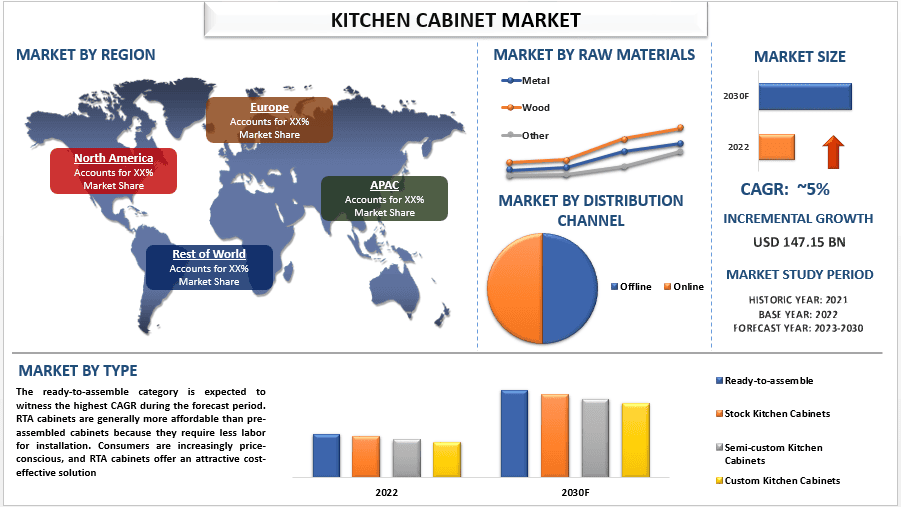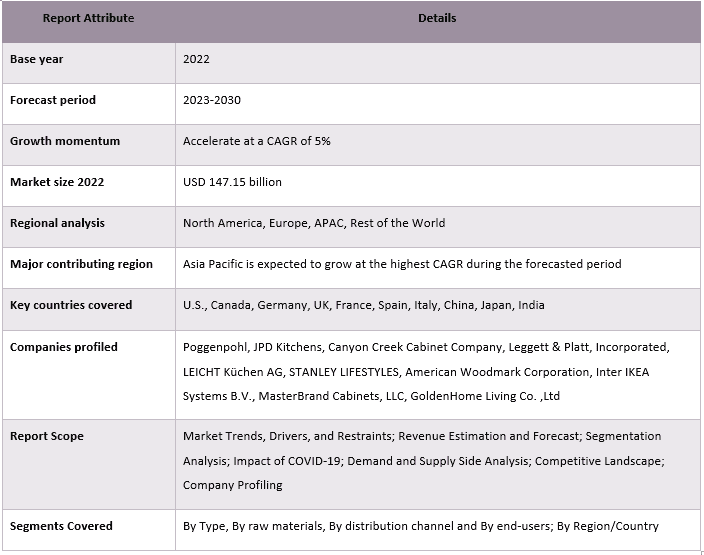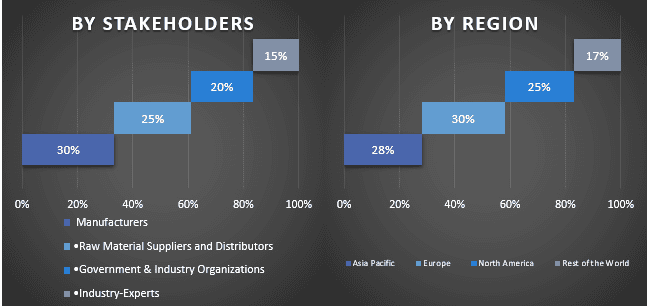- Startseite
- Über uns
- Industrie
- Dienstleistungen
- Lesen
- Kontaktieren Sie uns
Küchenschrankmarkt: Aktuelle Analyse und Prognose (2023-2030)
Schwerpunkt auf Typ (Selbstmontage, Lagerküchenschränke, Semimaßgefertigte Küchenschränke, Maßgefertigte Küchenschränke); Rohmaterial (Holz, Metall, Andere Rohmaterialien); Vertriebskanal (Offline, Online); Endverbraucher (Privathaushalte, Gewerbe); und Region/Land

Der Markt für Küchenschränke wurde im Jahr 2022 auf 147,15 Milliarden USD geschätzt und wird voraussichtlich mit einer CAGR von 5 % von 2023 bis 2030 wachsen. Der Begriff „Küchenschrank“ bezieht sich auf die Branche, die sich mit dem Design, der Herstellung und dem Verkauf von Küchenschränken und verwandten Küchenaufbewahrungslösungen befasst. Küchenschränke sind ein grundlegender Bestandteil des Küchendesigns und bieten Stauraum für Kochgeschirr, Utensilien und Lebensmittel, während sie gleichzeitig zur Gesamtästhetik der Küche beitragen. Der Markt für Küchenschränke wird von mehreren Faktoren angetrieben, die zu seinem Wachstum und seiner Popularität führen. Die Verbraucher werden designbewusster und suchen nach ästhetisch ansprechenden und funktionalen Küchenräumen. Dieser Wandel in den Verbraucherpräferenzen hat zu einem sprunghaften Anstieg der Nachfrage nach individuellen und stilvollen Küchenschrankoptionen geführt. Darüber hinaus sind sich viele Verbraucher zunehmend der Bedeutung der Küchenorganisation bewusst. Küchenschränke werden als essenzielle Aufbewahrungslösungen angesehen, die dazu beitragen können, Küchenräume aufzuräumen und zu optimieren, wodurch sie funktionaler werden. Dies sind die Schlüsselfaktoren, die die Einführung anorganischer Wachstumsstrategien unter den wichtigsten Akteuren der Branche weltweit fördern. Zum Beispiel hat Häfele UK im Mai 2021 eine neue Küchentürenreihe auf den Markt gebracht, die sein Angebot für den Küchenausbau vervollständigt. Die Reihe mit dem Titel Aspekt umfasst vier verschiedene Türstile – Standardplatte, gepresste Schranktür, integrierter J-Zug und eine Premiumplatte – die jeweils verschiedene Ausführungen in sieben verschiedenen Farboptionen bieten usw.
Einige der wichtigsten Akteure auf dem Markt sind Poggenpohl, JPD Kitchens, Canyon Creek Cabinet Company, Leggett & Platt, Incorporated, LEICHT Küchen AG, STANLEY LIFESTYLES, American Woodmark Corporation, Inter IKEA Systems B.V., MasterBrand Cabinets, LLC, GoldenHome Living Co. ,Ltd. Mehrere Fusionen und Übernahmen sowie Partnerschaften wurden von diesen Akteuren eingegangen, um Kunden mit Hightech- und innovativen Produkten/Technologien zu unterstützen.
Im Bericht dargestellte Erkenntnisse
„Unter den Typen hatte das Segment der Selbstbaumöbel im Jahr 2023 einen bedeutenden Marktanteil.“
Basierend auf dem Typ ist der Markt in Selbstbaumöbel, Lagerküchenschränke, teilkundenspezifische Küchenschränke und kundenspezifische Küchenschränke unterteilt. Es wird erwartet, dass die Kategorie der Selbstbaumöbel im Prognosezeitraum die höchste CAGR aufweisen wird. RTA-Schränke sind im Allgemeinen erschwinglicher als vormontierte Schränke, da sie weniger Arbeitsaufwand für die Installation erfordern. Die Verbraucher sind zunehmend preisbewusst, und RTA-Schränke bieten eine attraktive und kostengünstige Lösung. Darüber hinaus gewinnt der Do-it-yourself-(DIY)-Trend an Popularität, und viele Hausbesitzer sind bereit, die Installation von Küchenschränken als DIY-Projekt in Angriff zu nehmen. RTA-Schränke richten sich an diesen DIY-Markt, da sie mit leicht verständlichen Montageanleitungen geliefert werden.
„Unter den Rohstoffen hatte das Holzsegment im Jahr 2023 die höhere CAGR auf dem Markt.“
Basierend auf den Rohstoffen wurde der Markt für Küchenschränke in Holz, Metall und andere unterteilt. Unter diesen wird erwartet, dass das Holzsegment mit einer höheren CAGR auf dem Markt wachsen wird. Holz hat eine zeitlose und natürliche Schönheit, die viele Verbraucher anspricht. Es bietet ein warmes und klassisches Aussehen und ist somit eine bevorzugte Wahl für Küchenschränke. Darüber hinaus kann Holz leicht an verschiedene Designstile und Vorlieben angepasst werden. Jüngste Entwicklungen in der Holzbearbeitungstechnologie ermöglichen komplizierte Designs und eine breite Palette von Oberflächen. Darüber hinaus werden sich viele Verbraucher zunehmend der Umwelt bewusst, und Holzunternehmen haben darauf reagiert, indem sie nachhaltige und verantwortungsvoll beschaffte Holzmaterialien verwenden. Dieser Fokus auf Nachhaltigkeit steht im Einklang mit der wachsenden Nachfrage nach umweltfreundlichen Produkten.
„Asien-Pazifik dominierte im Jahr 2023 den Markt für Küchenschränke.“
Es wird erwartet, dass Asien-Pazifik im Prognosezeitraum mit einer beträchtlichen CAGR wachsen wird. Der Wohnungsbestand im asiatisch-pazifischen Raum altert, was zu einem erhöhten Bedarf an Hausrenovierungen führt. Viele Hausbesitzer entscheiden sich für die Renovierung ihrer Küchen, einschließlich des Austauschs von Schränken, als kostengünstige Möglichkeit, den Gesamtwert und die Funktionalität ihrer Häuser zu verbessern. Darüber hinaus erhöhen demografische Veränderungen, einschließlich des Zusammenlebens mehrerer Generationen und einer steigenden Anzahl von Haushalten mit zwei Verdienern, die Nachfrage nach größeren, funktionaleren Küchen mit ausreichend Stauraum, was den Bedarf an neuen und innovativen Schranklösungen antreibt. Darüber hinaus priorisieren aktuelle Designtrends oft offene Küchen mit individuellen und stilvollen Schrankoptionen. Diese Trends, einschließlich offener Regale, drängen Hausbesitzer dazu, ihre Schränke zu aktualisieren. Darüber hinaus hat das wachsende Umweltbewusstsein zu einer erhöhten Nachfrage nach umweltfreundlichen und nachhaltigen Küchenschränken geführt, wobei immer mehr Verbraucher nach Produkten suchen, die erneuerbare Materialien und umweltbewusste Herstellungsprozesse in der Region verwenden. Zum Beispiel setzte IKEA seine Expansion in der Region Asien-Pazifik im Jahr 2021 fort. Das Unternehmen eröffnete neue Geschäfte und erweiterte sein Produktsortiment, um den spezifischen Bedürfnissen und Designvorlieben der Kunden in der Region gerecht zu werden.
Abdeckung des Marktberichts für Küchenschränke

Gründe für den Kauf dieses Berichts:
- Die Studie umfasst eine Marktdimensionierungs- und Prognoseanalyse, die von authentifizierten wichtigen Branchenexperten validiert wurde.
- Der Bericht bietet einen schnellen Überblick über die Gesamtleistung der Branche auf einen Blick.
- Der Bericht enthält eine detaillierte Analyse der wichtigsten Branchenkollegen mit einem primären Fokus auf wichtige Finanzdaten des Unternehmens, Produktportfolios, Expansionsstrategien und jüngste Entwicklungen.
- Detaillierte Untersuchung der Treiber, Einschränkungen, wichtigsten Trends und Chancen, die in der Branche vorherrschen.
- Die Studie deckt den Markt umfassend über verschiedene Segmente hinweg ab.
- Tiefgreifende regionale Analyse der Branche.
Anpassungsoptionen:
Der globale Markt für Küchenschränke kann je nach Bedarf oder einem anderen Marktsegment weiter angepasst werden. Darüber hinaus versteht UMI, dass Sie möglicherweise Ihre eigenen geschäftlichen Anforderungen haben. Zögern Sie daher nicht, sich mit uns in Verbindung zu setzen, um einen Bericht zu erhalten, der Ihren Anforderungen vollständig entspricht.
Inhaltsverzeichnis
Forschungs-Methodik für die Küchenschrank Markt Analyse (2022-2030)
Die Analyse des historischen Marktes, die Schätzung des aktuellen Marktes und die Prognose des zukünftigen Marktes des globalen Küchenschrankmarktes waren die drei Hauptschritte, die unternommen wurden, um die Akzeptanz von Küchenschränken in wichtigen Regionen weltweit zu schaffen und zu analysieren. Es wurden umfassende Sekundärrecherchen durchgeführt, um die historischen Marktzahlen zu erfassen und die aktuelle Marktgröße zu schätzen. Zweitens wurden zahlreiche Erkenntnisse und Annahmen berücksichtigt, um diese Erkenntnisse zu validieren. Darüber hinaus wurden ausführliche Primärinterviews mit Branchenexperten entlang der Wertschöpfungskette des globalen Küchenschrankmarktes geführt. Nach der Annahme und Validierung der Marktzahlen durch Primärinterviews haben wir einen Top-Down/Bottom-Up-Ansatz verwendet, um die vollständige Marktgröße zu prognostizieren. Danach wurden Methoden zur Marktaufteilung und Datentriangulation angewendet, um die Marktgröße von Segmenten und Subsegmenten der betreffenden Branche zu schätzen und zu analysieren. Die detaillierte Methodik wird im Folgenden erläutert:
Analyse der historischen Marktgröße
Schritt 1: Detaillierte Untersuchung von Sekundärquellen:
Es wurde eine detaillierte Sekundärstudie durchgeführt, um die historische Marktgröße des Küchenschrankmarktes über unternehmensinterne Quellen wie Geschäftsberichte und Finanzberichte, Performance-Präsentationen, Pressemitteilungen usw. und externe Quellen wie Fachzeitschriften, Nachrichten und Artikel, Regierungsveröffentlichungen, Wettbewerbsveröffentlichungen, Branchenberichte, Datenbanken von Drittanbietern und andere glaubwürdige Veröffentlichungen zu erhalten.
Schritt 2: Marktsegmentierung:
Nachdem wir die historische Marktgröße des Küchenschrankmarktes erhalten hatten, führten wir eine detaillierte Sekundäranalyse durch, um historische Markteinblicke und Anteile für verschiedene Segmente und Subsegmente für wichtige Regionen zu sammeln. Wichtige Segmente, die im Bericht enthalten sind, sind Typ, Rohstoffe, Vertriebskanal und Endverbraucher. Darüber hinaus wurden Länderanalysen durchgeführt, um die allgemeine Akzeptanz von Testmodellen in dieser Region zu bewerten.
Schritt 3: Faktorenanalyse:
Nachdem wir die historische Marktgröße verschiedener Segmente und Subsegmente ermittelt hatten, führten wir eine detaillierte Faktorenanalyse durch, um die aktuelle Marktgröße des Küchenschrankmarktes zu schätzen. Darüber hinaus führten wir eine Faktorenanalyse unter Verwendung von abhängigen und unabhängigen Variablen wie Art, Rohstoffe, Vertriebskanal und Endverbraucher des Küchenschrankmarktes durch. Es wurde eine gründliche Analyse der Angebots- und Nachfrageszenarien unter Berücksichtigung der Top-Partnerschaften, Fusionen und Übernahmen, Geschäftsausweitungen und Produkteinführungen im Küchenschrankmarktsektor weltweit durchgeführt.
Aktuelle Markengrößenschätzung & Prognose
Aktuelle Marktgröße: Basierend auf verwertbaren Erkenntnissen aus den oben genannten 3 Schritten haben wir die aktuelle Marktgröße, die wichtigsten Akteure auf dem globalen Küchenschrankmarkt und die Marktanteile der Segmente ermittelt. Alle erforderlichen prozentualen Anteile und Marktaufteilungen wurden unter Verwendung des oben genannten sekundären Ansatzes ermittelt und durch Primärinterviews verifiziert.
Schätzung & Prognose: Für die Marktschätzung und -prognose wurden verschiedenen Faktoren, einschließlich Treibern & Trends, Beschränkungen und Chancen für die Stakeholder, Gewichte zugewiesen. Nach der Analyse dieser Faktoren wurden relevante Prognosetechniken, d.h. der Top-Down/Bottom-Up-Ansatz, angewendet, um die Marktprognose für 2030 für verschiedene Segmente und Subsegmente in den wichtigsten Märkten weltweit zu erstellen. Die Forschungsmethodik zur Schätzung der Marktgröße umfasst:
- Die Marktgröße der Branche in Bezug auf Umsatz (USD) und die Akzeptanzrate des Küchenschrankmarktes in den wichtigsten Märkten im Inland
- Alle prozentualen Anteile, Aufteilungen und Aufschlüsselungen von Marktsegmenten und Subsegmenten
- Wichtige Akteure auf dem globalen Küchenschrankmarkt in Bezug auf angebotene Produkte. Auch die von diesen Akteuren angewandten Wachstumsstrategien, um im schnell wachsenden Markt zu bestehen
Validierung der Marktgröße und -anteile
Primärforschung: Es wurden ausführliche Interviews mit den Key Opinion Leaders (KOLs) geführt, darunter Top Level Executives (CXO/VPs, Vertriebsleiter, Marketingleiter, Betriebsleiter, Regionalleiter, Länderchef usw.) in den wichtigsten Regionen. Die Ergebnisse der Primärforschung wurden dann zusammengefasst und eine statistische Analyse durchgeführt, um die aufgestellte Hypothese zu beweisen. Die Beiträge aus der Primärforschung wurden mit den Ergebnissen der Sekundärforschung zusammengeführt, wodurch Informationen in verwertbare Erkenntnisse umgewandelt wurden.
Aufteilung der primären Teilnehmer in verschiedene Regionen

Market Engineering
Die Datentriangulationstechnik wurde angewendet, um die gesamte Marktschätzung abzuschließen und präzise statistische Zahlen für jedes Segment und Subsegment des globalen Küchenschrankmarktes zu erhalten. Die Daten wurden in mehrere Segmente und Subsegmente aufgeteilt, nachdem verschiedene Parameter und Trends in den Bereichen Typ, Rohstoffe, Vertriebskanal und Endverbraucher auf dem globalen Küchenschrankmarkt untersucht wurden.
Das Hauptziel der Globalen Küchenschrankmarktstudie
Die aktuellen und zukünftigen Markttrends des globalen Küchenschrankmarktes wurden in der Studie genau bestimmt. Investoren können strategische Einblicke gewinnen, um ihre Entscheidungen für Investitionen auf der Grundlage der in der Studie durchgeführten qualitativen und quantitativen Analyse zu treffen. Aktuelle und zukünftige Markttrends bestimmten die Gesamtattraktivität des Marktes auf regionaler Ebene und boten dem industriellen Teilnehmer eine Plattform, um den unerschlossenen Markt zu nutzen und von einem First-Mover-Vorteil zu profitieren. Weitere quantitative Ziele der Studien sind:
- Analyse der aktuellen und prognostizierten Marktgröße des Küchenschrankmarktes in Bezug auf den Wert (USD). Analysieren Sie auch die aktuelle und prognostizierte Marktgröße verschiedener Segmente und Subsegmente
- Zu den Segmenten in der Studie gehören die Bereiche Typ, Rohstoffe, Vertriebskanal und Endverbraucher
- Definition und Analyse des regulatorischen Rahmens für die Küchenschrankindustrie
- Analyse der Wertschöpfungskette mit der Präsenz verschiedener Vermittler sowie Analyse des Kunden- und Wettbewerbsverhaltens der Branche
- Analyse der aktuellen und prognostizierten Marktgröße des Küchenschrankmarktes für die Hauptregion
- Zu den wichtigsten Ländern der im Bericht untersuchten Regionen gehören der asiatisch-pazifische Raum, Europa, Nordamerika und der Rest der Welt
- Unternehmensprofile des Küchenschrankmarktes und die von den Marktakteuren angewandten Wachstumsstrategien, um sich im schnell wachsenden Markt zu behaupten
- Tiefgehende regionale Analyse der Branche
Häufig gestellte Fragen FAQs
F1: Wie groß ist die aktuelle Marktgröße und das Wachstumspotenzial des globalen Marktes für Küchenschränke?
F2: Was sind die treibenden Faktoren für das Wachstum des globalen Küchenschrankmarktes?
F3: Welches Segment hat den größten Anteil am globalen Markt für Küchenschränke nach Typ?
F4: Welche neuen Chancen gibt es auf dem globalen Markt für Küchenschränke?
F5: Welche Region wird den globalen Markt für Küchenschränke dominieren?
F6: Wer sind die wichtigsten Akteure auf dem globalen Markt für Küchenschränke?
Verwandt Berichte
Kunden, die diesen Artikel gekauft haben, kauften auch










